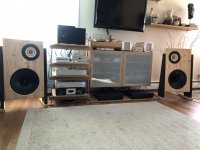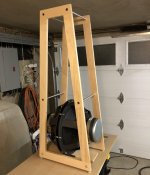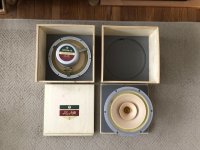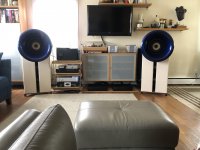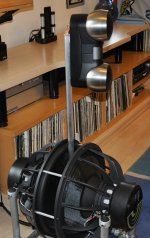No....dont want to get into box construction. My intention was to use OB and my conclusion is FR drivers will not do rock in OB configuration.
I dont care if they sound better in a box, and maybe you can run the test.
For arguements sake here is the KEF run OB:
I dont care if they sound better in a box, and maybe you can run the test.
For arguements sake here is the KEF run OB:
Attachments
Hi
It’s only normal that your speakers arrangement does poorly with Rock, based on your graphic you’ve got basically no basss (60-250Hz). My setup is an H baffle with full range and sounds amazing and great for everything including rock.
BR
Eric
It’s only normal that your speakers arrangement does poorly with Rock, based on your graphic you’ve got basically no basss (60-250Hz). My setup is an H baffle with full range and sounds amazing and great for everything including rock.
BR
Eric
No....dont want to get into box construction. My intention was to use OB and my conclusion is FR drivers will not do rock in OB configuration.
I dont care if they sound better in a box, and maybe you can run the test.
For arguements sake here is the KEF run OB:
Since you have no baffle whatsoever for your woofers and full range you could say that your system isn’t fit to well reproduce rock on a baffle free setup.
Since you have no baffle, please call it baffle free or something, not OB.
Good luck and keep us posted
Eric
Thanks Eric.
I dont want to respond at length as its off-topic. I thought the OP may benefit from my experience using different FR drivers in OB/WAW configuration.
All I will say is I dont have any issues with my set-up now and the graphs are only showing the FR's as the labelling shows..
Out of curiosity, what FR are you using, what amp are you using, and how loud do you play?
I dont want to respond at length as its off-topic. I thought the OP may benefit from my experience using different FR drivers in OB/WAW configuration.
All I will say is I dont have any issues with my set-up now and the graphs are only showing the FR's as the labelling shows..
Out of curiosity, what FR are you using, what amp are you using, and how loud do you play?
Last edited:
...and my conclusion is FR drivers will not do rock in OB configuration.
You just aren’y using the right FR. To play rock with the impact often expected when listening to rock, it is the bass support that makes or breaks the OB. The FR has only to keep up. To do that on an OB one needs lots of swept volume. And the bigger the baffle the better.
So i would say you have not explored far enuff, i would suggest your conclusion is wrong.
I have heard OBs that kjust lve to play rock. I didn’t like some of the other things it did, but they rocked for hours on the front apron (ie outside, not a small room. much harder to do.
dave
As i said, not really the FRs.
Alpair 12p or A10p (my preference) make excellent midTweeters that should allow you to keep up with the woofers (2x15” minimum?). Biamping suggestted.
Althou i have not personally been a big OB fan, i have 1 more still percolating. The key is the 4x10” OB specific woofers on each side.
dave
Alpair 12p or A10p (my preference) make excellent midTweeters that should allow you to keep up with the woofers (2x15” minimum?). Biamping suggestted.
Althou i have not personally been a big OB fan, i have 1 more still percolating. The key is the 4x10” OB specific woofers on each side.
dave
Dave....I been through the whole Alpair range.
For a system to do rock in my book means achieving 105db levels. That would send the 12P cones into orbit!
Anyway....I am not after advice, but thanks.
For a system to do rock in my book means achieving 105db levels. That would send the 12P cones into orbit!
Anyway....I am not after advice, but thanks.
As i said, it is not the FR, it is the bass. 105dB is a painful level if that is average, if you listen that loud for extended periods time to start saving up for hearing aids. 105dB peaks should be easy. About 20w peks into an A12p. It should not be operating anywhere where they actually think they are in an OB. Of course amp quality up top will make a big difference as the alpairs will reveal many faults.
If you represent the former, good luck you need a small PA, the latter suggests you did not get the bass right, not much at all to do with the FRs.
dave
If you represent the former, good luck you need a small PA, the latter suggests you did not get the bass right, not much at all to do with the FRs.
dave
I’ve taken a sidetrack through open baffle while I regroup on a new multiway horn project.
Actually, I’ve also used horns with no backchamber for quite a while...almost like an open baffle waveguide?
The 8” fullrange was the simplest way I thought I could could get into experimenting with speakers since crossovers and all their complexity was too much.
So I eventually ended up with a few...Fostex 206e, Tang Band W8-1808 and Lowther DX3.
Out of the three my impression was that the Fostex packed the biggest punch and could easily outplay the other two when it came to Rock. It did a good job of it.
The Tang Band was the most laid back, easiest to listen to and the least efficient.
The Lowther (which I played with the longest) had the potential to give the most detail and resolution to my ears. It did require using a shelf filter in order for certain frequencies to not irritate me. This became a breeze once I acquired a used First Watt B5.
I listen to all kinds of music, but I think I would say I spend the most time listening to Jazz. Especially small ensembles...and I really enjoy the ambiance of recordings of live performances.
I alternate using my ACA monoblocks and my F2J monoblocks...neither are close to being “powerful”...but I can easily annoy others with the attainable levels.
I’m currently using a pair of AE Dipole 15 for bass with some old bridged Rotel HT amps powering them.
I’m moving on to a partially baffleless setup with a pair of AE Dipole 18 per side which I will run off some Hypex Ncore amps.
They will be used for the bottom end for the new horn system, but for now I’ve picked up a pair of used Lii Audio Crystal 10 to try up top.
Actually, I’ve also used horns with no backchamber for quite a while...almost like an open baffle waveguide?
The 8” fullrange was the simplest way I thought I could could get into experimenting with speakers since crossovers and all their complexity was too much.
So I eventually ended up with a few...Fostex 206e, Tang Band W8-1808 and Lowther DX3.
Out of the three my impression was that the Fostex packed the biggest punch and could easily outplay the other two when it came to Rock. It did a good job of it.
The Tang Band was the most laid back, easiest to listen to and the least efficient.
The Lowther (which I played with the longest) had the potential to give the most detail and resolution to my ears. It did require using a shelf filter in order for certain frequencies to not irritate me. This became a breeze once I acquired a used First Watt B5.
I listen to all kinds of music, but I think I would say I spend the most time listening to Jazz. Especially small ensembles...and I really enjoy the ambiance of recordings of live performances.
I alternate using my ACA monoblocks and my F2J monoblocks...neither are close to being “powerful”...but I can easily annoy others with the attainable levels.
I’m currently using a pair of AE Dipole 15 for bass with some old bridged Rotel HT amps powering them.
I’m moving on to a partially baffleless setup with a pair of AE Dipole 18 per side which I will run off some Hypex Ncore amps.
They will be used for the bottom end for the new horn system, but for now I’ve picked up a pair of used Lii Audio Crystal 10 to try up top.
Attachments
Love your bass, Chromenuts 😀
We have gone through a similar journey....in particular the crossover bit.
I would say all the FR's needed some kind of filtering, particularly between 1-4k. The TangBands were unlistenable. I too started listening to more jazz!
In the end, I concluded FR's were not going to give me what I was after, and went for the Gallo sealed enclosures which used a tweeter. Being bafflless, this gave an OB type of presentation. The enclosure was metal and totally inert. This was coupled to my naked dipole bass arrangement....similar to yours.
The Gallos did everything I wanted.....no eq.
Now I have discovered the KEF pods. 1/10th cost.....and twice as good!
We have gone through a similar journey....in particular the crossover bit.
I would say all the FR's needed some kind of filtering, particularly between 1-4k. The TangBands were unlistenable. I too started listening to more jazz!
In the end, I concluded FR's were not going to give me what I was after, and went for the Gallo sealed enclosures which used a tweeter. Being bafflless, this gave an OB type of presentation. The enclosure was metal and totally inert. This was coupled to my naked dipole bass arrangement....similar to yours.
The Gallos did everything I wanted.....no eq.
Now I have discovered the KEF pods. 1/10th cost.....and twice as good!
Attachments
Last edited:
vibration cancellation probably. There is a little slot loading going on that helps control cone excursion.
I think you are not really clear on some concept. One look at the graphs and I can tell you what your setup sounds like... no body. You need the frequency response between 200 to 600Hz to give it body and it is pretty much missing.Love your bass, Chromenuts 😀
We have gone through a similar journey....in particular the crossover bit.
I would say all the FR's needed some kind of filtering, particularly between 1-4k. The TangBands were unlistenable. I too started listening to more jazz!
In the end, I concluded FR's were not going to give me what I was after, and went for the Gallo sealed enclosures which used a tweeter. Being bafflless, this gave an OB type of presentation. The enclosure was metal and totally inert. This was coupled to my naked dipole bass arrangement....similar to yours.
The Gallos did everything I wanted.....no eq.
Now I have discovered the KEF pods. 1/10th cost.....and twice as good!
Being sealed, It is definitely not open baffle, it is just sealed in narrow baffle or baffle less. It will still give out a lot more bass.
I think you are getting the concept of WAW full range, OB and no electronics mixed up. They are mutually exclusive.
I have heard the same full range driver in no baffle, open baffle and sealed. For example the 3fe22 could easily go down to 150 to 200 Hz in a sealed. An a open baffle would require a plank that is at least as wide as your 18" woofer.
The sound wave from the back of the speaker cancels everything in the front. Resulting in pretty much no bass especially if your driver is only 3". That is the purpose of the baffle or the sealed chamber to prevent the sound from the back from cancelling the front.
If you run baffleless, the bass will start cutting at about probably 700Hz. With a sealed depending on drivers about 100 to 200Hz. However, you would need to size it appropriately.
BTW, some of the full ranges you use including 3FE22 are PA drivers, which means they are intended for rock concerts. If you had a line array in a sealed or even open baffle they will go crazy loud.
Second matter, full range means it will run all frequencies, however it doesn't mean no electronics. It still requires a bit of equalization for best effect. Most full range still has a rising response as frequency increases. You will also need a baffle step filter.
The purpose of having full range WAW is to avoid having a crossover to two different drivers. But otherwise the cabinets and electronics (coils and caps) are still required. The gallo and KEF and all multidriver circuits implement it in their crossover. And of course a high pass to prevent your low frequency from getting into you full range.
Best of luck.
Oon
I’ve taken a sidetrack through open baffle while I regroup on a new multiway horn project.
Actually, I’ve also used horns with no backchamber for quite a while...almost like an open baffle waveguide?
The 8” fullrange was the simplest way I thought I could could get into experimenting with speakers since crossovers and all their complexity was too much.
So I eventually ended up with a few...Fostex 206e, Tang Band W8-1808 and Lowther DX3.
Out of the three my impression was that the Fostex packed the biggest punch and could easily outplay the other two when it came to Rock. It did a good job of it.
The Tang Band was the most laid back, easiest to listen to and the least efficient.
The Lowther (which I played with the longest) had the potential to give the most detail and resolution to my ears. It did require using a shelf filter in order for certain frequencies to not irritate me. This became a breeze once I acquired a used First Watt B5.
I listen to all kinds of music, but I think I would say I spend the most time listening to Jazz. Especially small ensembles...and I really enjoy the ambiance of recordings of live performances.
I alternate using my ACA monoblocks and my F2J monoblocks...neither are close to being “powerful”...but I can easily annoy others with the attainable levels.
I’m currently using a pair of AE Dipole 15 for bass with some old bridged Rotel HT amps powering them.
I’m moving on to a partially baffleless setup with a pair of AE Dipole 18 per side which I will run off some Hypex Ncore amps.
They will be used for the bottom end for the new horn system, but for now I’ve picked up a pair of used Lii Audio Crystal 10 to try up top.
Hi Chromenuts,
Love what you did. However, my 2cents. I find most fullrange speakers above 4" require a super tweeter. Can just be a half inch tweeter with a 1 or 2 uf capacitor in series. Or ideally a ribbon or amt type.
IMHO, the whole purpose of running a full range in a multiway system is to avoid having a crossover in the sensitive region of 500Hz to 5000Hz. So a helper tweeter is something that can really enhance the sound. You may or may not need to roll off the full range. Only yours can tell.
I would love to hear your impression of the Lii Audio once you installed it. New players on the block.
Oon
I think you are not really clear on some concept. One look at the graphs and I can tell you what your setup sounds like... no body. You need the frequency response between 200 to 600Hz to give it body and it is pretty much missing.
Being sealed, It is definitely not open baffle, it is just sealed in narrow baffle or baffle less. It will still give out a lot more bass.
I think you are getting the concept of WAW full range, OB and no electronics mixed up. They are mutually exclusive.
I have heard the same full range driver in no baffle, open baffle and sealed. For example the 3fe22 could easily go down to 150 to 200 Hz in a sealed. An a open baffle would require a plank that is at least as wide as your 18" woofer.
The sound wave from the back of the speaker cancels everything in the front. Resulting in pretty much no bass especially if your driver is only 3". That is the purpose of the baffle or the sealed chamber to prevent the sound from the back from cancelling the front.
If you run baffleless, the bass will start cutting at about probably 700Hz. With a sealed depending on drivers about 100 to 200Hz. However, you would need to size it appropriately.
BTW, some of the full ranges you use including 3FE22 are PA drivers, which means they are intended for rock concerts. If you had a line array in a sealed or even open baffle they will go crazy loud.
Second matter, full range means it will run all frequencies, however it doesn't mean no electronics. It still requires a bit of equalization for best effect. Most full range still has a rising response as frequency increases. You will also need a baffle step filter.
The purpose of having full range WAW is to avoid having a crossover to two different drivers. But otherwise the cabinets and electronics (coils and caps) are still required. The gallo and KEF and all multidriver circuits implement it in their crossover. And of course a high pass to prevent your low frequency from getting into you full range.
Best of luck.
Oon
Oon, you are not getting the picture here. The graphs I posted do not include the woofers. Genius for figuring out they would sound thin.
And I know if I put the drivers in a baffle, I would get more bass.....but I would also get more artifacts and my imageing would suffer. Dont tell me it wont because I tried it. That is the purpose of WAW, to fill in the bass.
My conclusions are based on real world testing. You read my Trans-fi blog, you should know this. And dont tell me my hearing must be crap. I developed and sold over 500 Terminator tonearms. I am also the guy that developed the Faital Line Array, which does go crazy loud.....but not as loud as the PRV array.
My point is it is not possible for me to get the sound quality I desire using a full ranger, even with my DEQX. They all tend to break up. I will be honest and tell you I dont know if they break up in a box. I was trying to find something that worked naked. Hence I have now gone back to box/crossover....so Kudos to the guys in the multi-driver section.
And I know I am no longer running OB at the top. This is where my journey has taken me. I am running a hybrid now which is giving me what I want.
You dont have to wish me luck. I know where I am going.
Last edited:
What's the purpose of two drivers facing each other?
They are wired electronically out of phase, acoustically in phase....a concept pioneered by Celestion in the 80's.
Gives better control, directivity and room integration.
This is a link to Vic loudspeaker journey
Trans-Fi Audio - DIY SPEAKER BLOG
The bass on UM18 are the best I have ever heard and that is including some really expensive systems. The Kefs imo take the rest of the system into the same league.
The Faitals were my favourite full range using these as line arrays I could do justice to Dream Theater but they definitely did not like to be pushed to hard. The Kefs for me I can push as hard as I want and trust me I can push them pretty hard.
Trans-Fi Audio - DIY SPEAKER BLOG
The bass on UM18 are the best I have ever heard and that is including some really expensive systems. The Kefs imo take the rest of the system into the same league.
The Faitals were my favourite full range using these as line arrays I could do justice to Dream Theater but they definitely did not like to be pushed to hard. The Kefs for me I can push as hard as I want and trust me I can push them pretty hard.
Gives better control, directivity and room integration.
How so? It's so rarely done, I query whether it has much/any effect.
- Home
- Loudspeakers
- Full Range
- Suitable fullrange for a WAW OB

